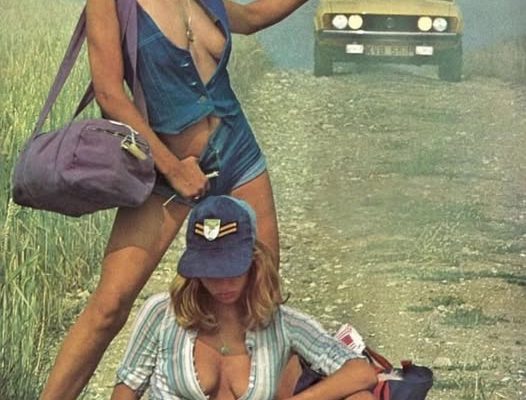Picture this: two young women stand on a dusty backroad, dressed in bold yet laid-back outfits, their luggage by their side. One raises her arm to catch a ride, while the other adjusts her gear with a relaxed air. The faded light, vintage vibes, and rugged landscape hint at a time when hitchhiking wasn’t just travel—it was a way of life, a bold claim to independence, and a gateway to exploration. Welcome to the 1970s, America’s peak hitchhiking era, when the highways beckoned and adventurers answered the call.

The Birth of a Travel Tradition
Hitchhiking, or “thumbing a ride,” was once a cherished and celebrated way to roam the United States. Its roots stretch back to the 1920s and 1930s, but it truly took off after World War II as people chased new horizons. By the 1960s and 1970s, it hit its stride, driven by a wave of free-spirited travelers, hippies, and dreamers eager to discover America’s endless roads.
For these wanderers, hitchhiking was more than a ride—it was a leap into the unknown, a chance to connect with strangers, and a raw glimpse of the nation’s heart. Back then, offering a lift wasn’t a risk; it was a friendly gesture, a nod to shared community.
Video Jane Fonda \ Walk On The Wild Side 1962 \ hitchhiking
What Made Hitchhiking a Hit?
- Affordable Travel: For cash-strapped students and roamers, hitchhiking was the go-to option—no need for pricey cars or tickets.
- Trusting Times: Mid-20th-century America embraced a sense of openness, where strangers weren’t feared but welcomed.
- Call of the Wild: The thrill of unplanned journeys fueled the era’s rebellious, carefree spirit.
- Hippie Influence: Young explorers hitched to iconic spots like Woodstock, Route 66, and San Francisco’s Haight-Ashbury, chasing music and counterculture dreams.
- Highway Boom: Sprawling interstates and scenic routes like Route 66 turned long treks into scenic adventures.

The Fade of a Freewheeling Era
By the late 1970s and early 1980s, hitchhiking began to vanish from the roads. What shifted the tide?
- Rising Caution: Media stories and films like The Hitcher (1986) cast hitchhiking as risky, amplifying public fears.
- Legal Barriers: New state laws banned standing on highways to flag rides, curbing the practice.
- Travel Alternatives: Affordable buses, budget flights, and more cars made hitchhiking less essential.
- Changing Mindsets: As safety concerns grew, the once-common act lost its cultural footing.
Video How to Hitchhike Across America for FREE
A Lasting Echo in Pop Culture
Though hitchhiking is now a rarity, its spirit endures in American storytelling. Classics like Jack Kerouac’s On the Road and films like Easy Rider (1969) painted it as a bold rite of passage. Songs like The Eagles’ Take It Easy bottled the open-road freedom that defined the time.
Hitchhiking may not reclaim its past glory, but it stands as a vivid emblem of an America that felt vast, untamed, and ripe for discovery.

